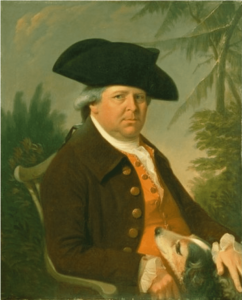
June 5th, 2023
This entry describes a typical British merchant who invested in the slave trade over several voyages and made his fortune therein.
Lancaster was the 4th largest slave port in Britain and was at its peak between the years 1740 and 1770 and between the years 1738 and 1807 around 25,000 enslaved Africans were transported on Lancaster ships. Dodshon Foster was a Durham born merchant who came to Lancaster to seek his fortune in his early twenties. He married Elizabeth Birket daughter of the prominent merchant and Lancaster Quaker Myles Birket helping him to establish and connect himself in the trading networks of the city. Together with his partner John Heathcote, he bought the 40 tonne vessel the Barlborough in 1752 and fitted it for the slave trade. It made three voyages all traversing the Transatlantic Slave Trade between Lancaster, the West Coast of Africa and Kingston, Jamaica. For the first two voyages in 1752-3 & 1754-5 the captain Richard Millerson was contracted and for the last voyage of 1755-6 John Tallon was the captain and she sailed with a crew of between 14 & 18 sailors.

Each Barlborough slave ship voyage was just under a year and it embarked with trade goods to Africa such as copper kettles, iron bars, beads, hats, gunpowder and fine cloths to trade for enslaved Africans to be sold in the Caribbean where they were exchanged for plantation staples such as sugar, rum, tobacco, cotton and mahogany. The first voyage shipped 118 Africans but 17 died on the voyage, the second 164 but 24 perished while on the third voyage 168 were shipped but only 144 reached Jamaica. These death rates of around 15% are not unusual for Lancaster ships.
The Barlborough was sold in 1758 as he cashed in his investment. Foster was a very successful slave trader serving as one of Lancaster’s Port Commissioners between 1754 and 1758 making enough money to establish a house and warehouse on St. George’s Quay the main landing place for goods from the trade, right beside the prestigious Custom House in Lancaster built in 1764.
By this date most of his business interests were in trading with the West Indies and hence slave-produced goods rather than in the Transatlantic Slave Trade, though he continued small scale investments in slave ships.
Foster and his partner Heathcote were both Quakers, though this was no barrier to their involvement even after 1761 when the movement recommended that Quakers found to have slaves should be disowned. Foster’s involvement in the trading of enslaved Africans was also not a barrier to his being buried in the grounds of the Quaker Meeting House in 1793. His portrait has been prominently displayed for decades in the Custom House which now houses the City’s Maritime Museum. Painted by William Tate, the portrait figures Foster as a distinguished merchant at ease with his dog and the tropical background is designed to exemplify his status as a trader whose money has been made far from British shores. The contemporary artist, Sue Flowers, in her One Tenth installation for the Abolished exhibition in 2007 called out Foster’s notorious biography as a slave trader to face his portrait with a representation in sugar canes of one tenth of the Africans he had enslaved shaped as though bodies in the deck of a slave ship. In other parts of the museum she depicted his face behind the protective bars of the window frames as a modern day criminal.

His own times failed to judge his crimes against humanity, but now in this installation at least he is named and shamed. On the Lancaster Slave Trade, Abolition and Fair Trade Trail published in 2020, Foster is a key exemplar, showing how young men made their fortune in the trade through trading and family alliances that mediated the risks of the uncertain trade, and how his membership of the Quakers was no barrier to being involved in the trade despite their growing opposition to it through the eighteenth century. Dodshon Foster was a typical Lancaster slave trader one of dozens who saw no shame in what they saw as a “respectable trade”, one we now recognise as steeped in the blood of its African victims.
About the author
Alan Rice, Professor in English and American Studies, Director of UCLan Research Centre in Migration, Diaspora and Exile (MIDEX) and Co-Director of the Institute for Black Atlantic Research (IBAR) at the University of Central Lancashire, UCLan.
ory.
Bibliography
Simon Newman, Freedom Seekers: Escaping from Slavery in Restoration London, London: University of London Press, 2022. Downloadable HERE
Gretchen Gerzina, Black England, London: Hodder and Stoughton, 2022.
Alan Rice, Radical Narratives of the Black Atlantic, London: Continuum, 2003.
Alan Rice, Creating Memorials: Building Identities: The Politics of Memory in the Black Atlantic, Liverpool: University of Liverpool Press, 2010.
All rights reserved | Privacy policy | Contact: comms[at]projectmanifest.eu

Lorem Ipsum is simply dummy text of the printing and typesetting industry. Lorem Ipsum has been the industry's standard dummy text ever since the 1500s, when an unknown printer took a galley of type and scrambled it to make a type specimen book.